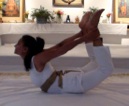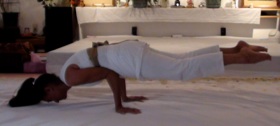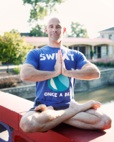KRIPALU
The Illustrations: Pictures and Videos
-
-
6.Kripalu Yoga: Dharana (concentration, focused or fixed mind on a single object)
-
A.Asanas (yogic postures or poses)
-
(with active/passive breathing or pranayama)
-
a. Thakor Patel, b. Parool Patel, c. Eric Banter









-
B.Bandhas (locks)
-
(with active breathing or pranayama)
-
C.Slow Motion Prana Movements/Exercises, Video
-
(with active/passive breathing or pranayama)
-
a.Thakor Patel (May 2011): hands/arms floating up in sitting position
-
b.Eric Banter (May 2011): hands/arms floating up in savasana position-overhead and back
-
7.Kripalu Meditation: Dhyana (complete concentration of mind)
-
Various mental states in meditation: Tandra (drowsiness), Nidra (yogic sleep), murcha (swoon), samadhi (super-consciousness)- savikalpa
-
-
A.Moving Meditation/Meditation in Motion, Video
-
(With active/passive pranayama)
-
a.Thakor Patel, May 1995
-
b.Eric Banter, May 2011
-
B. Still Meditation (With active/passive pranayama)
6 & 7. Kripalu Yoga & Meditation: Dharana & Dhyana
-
A. Pranic/Therapeutic Application of Various Postures Movement and Pranayama, Video
-
(With active/passive pranayama)
-
a.Thakor Patel
-
b.Eric Banter
-
-
B.Yogic Dance/Dhyana Mudras/Movements/Spiritual Dances, Video
-
(With active/passive pranayama)
-
With Bapuji’s Dhuns and Bhanjans Music Played
-
a.Thakor Patel
-
b.Thakor Patel leading the movements/dances and/or the participants following him
-
c.Spiritual dances in group: Garba and Dandia Rass (clapping with hands and/or playing with wood sticks)
-
To Improvise prana energy and to experience meditation, moving through specific energy forms such as ‘circle’, figure eight (8) and spinning around, in both directions.
-
-
-
8.Kripalu Meditation & Samadhi: (the state of super-consciousness and perfect bliss)
-
(With active/passive pranayama)
-
A.Mudras (developed forms of asanas with/without locks)
-
The following ten predominantly important mudras in which ‘prana’ has the primary place and the bodily organs have the subsidiary one.
-
-
B.Dhyanmudras (the developed forms of standing postures in the state of meditation with/without locks)
-
-
C.Still Meditation/Samadhi and the dissolution of the mind
-
(with passive pranayama)
Kripalu/Bapuji has demonstrated various Dhyanmudras. The following some of them are:



Moolbandhamudra, Uddiyana bandhamudra, Jalandharbandhamudra


Mahamudra, Mahavedhmudra



Mahabandhmudra, Vipritkaranimudra, Yonimudra, Vajrolimudra


Shaktichalanamudra, Khecharimudra
Still Meditation/Samadhi


